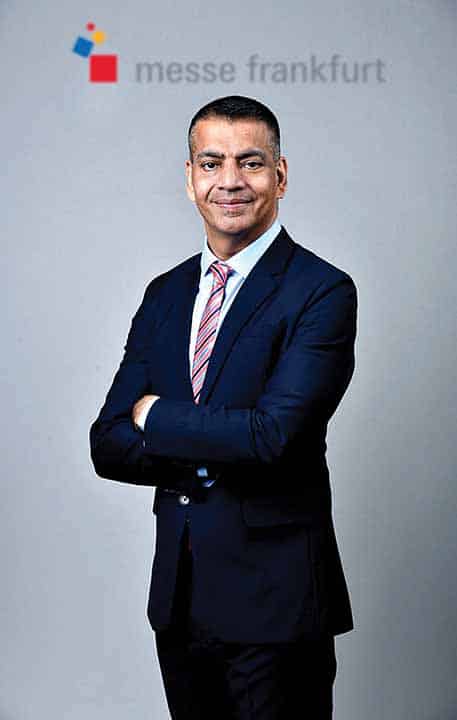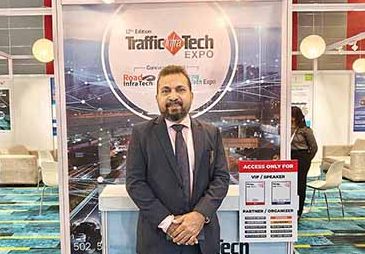In an upfront conversation, Raj Manek, Executive Director & Board Member, Messe Frankfurt Asia Holdings Ltd. speaks of success in infrastructure and mobility intertwined with culture creation to Ashish Bhatia.
Q. What are the major trends in infrastructure and mobility across the globe for different automotive segments?
A. Across the globe, the integration of electric and autonomous vehicles is shaping the future of mobility for both passenger and commercial vehicles. Electric Vehicle (EV) infrastructure, such as charging stations, and autonomous driving technologies is advancing rapidly in Western nations, supported by Intelligent Traffic Systems (ITS) and dedicated commercial corridors. In India, government-led expansions in road networks and urban planning initiatives are paving the way for modern mobility solutions.
As infrastructure scales up, strategic adoption of EV technology and automated systems will play a pivotal role in shaping India’s mobility landscape. IoT devices, radar sensors, navigation controls, monitoring and surveillance systems, and more such advanced solutions are growing in the industry.
The recently concluded TrafficInfratech Expo jointly organised by Messe Frankfurt Trade Fairs India and VIS Group also displayed several advanced tech-based solutions and emphasised India’s unique needs—where strong policies, especially around rule compliance, are essential to harness these advancements effectively.
Q. In your extensive experience, have technological advancements and safety standards led to the expected improvements in global infrastructure and at the desired pace?
A. Technological advancements have driven global improvements, with many nations implementing standards like Advanced Driver Assistance Systems (ADAS) – which is widely used in India, crash avoidance and stringent emissions testing to enhance safety and sustainability. Countries with strict adherence to these safety standards have seen significant benefits. In India, infrastructure projects are accelerating, but achieving a comparable impact depends on ensuring public compliance and safety adherence. Technology alone cannot drive change without enforcement. India’s infrastructure advancements will gain more traction as safety standards and public rule-following become integral parts of the framework.
Q. How do government interventions and compliance mandates contribute to driving change in this industry? How does it compare to the global markets?
A. Government interventions are crucial in shaping infrastructure growth, from highway expansions to urban planning initiatives. If we talk about other countries, they have adopted strict safety rules and emissions standards such as mandatory airbags, Electronic Stability Control (ESC), emissions testing, and more that help enhance road safety. The regulations abroad are devised keeping in mind their needs. When it comes to India, we need to build and develop our own. India is progressively aligning with the global best practices, but the impact depends on rigorous enforcement and public compliance. At TrafficInfraTech Expo we had several exhibitors showcasing the tech-based products and solutions backed by AI. Systems like GNSS toll collection systems, advanced surveillance and tracking systems and other such products for traffic management, parking management and road infrastructure can aid in effective management. For India to achieve lasting improvements, interventions must focus on infrastructure, urban planning and making mandatory culture of rule adherence.
Q. Compare India’s progress with the advanced economies.
A. Advanced economies have achieved robust infrastructure supported by strict safety regulations and high public compliance, making their intelligent transport systems more effective. India is rapidly scaling up infrastructure, including highways, expressways and smart city planning, but faces challenges with public compliance. While India’s projects are promising, success will hinge on creating a culture where road safety and rule-following are second nature, aligning India’s infrastructure advancements more closely with global standards.
Q. Are vehicle capabilities keeping pace with the development of new infrastructure, particularly the new transport corridors in terms of road worthiness?
A. In India, the alignment of vehicle standards with new transport corridors is crucial for road safety and optimal infrastructure use. While newer vehicles are equipped with safety features, many older models lack the necessary technology for high-speed corridors. Globally, standards like crash avoidance systems and stability control help ensure road worthiness on advanced infrastructure. For India, upgrading vehicle standards alongside infrastructure development is essential to maximize safety Compliance and maintenance standards will ensure that vehicles complement the country’s fast-evolving transport network effectively.
Q. Trade fairs are making a marked improvement post-COVID-19. How optimistic are you about achieving new milestones with the upcoming calendar of events?
A. Post-COVID, trade fairs have seen a strong recovery, with high engagement and participation. In India, this resurgence aligns well with the government’s infrastructure push, creating demand for networking and partnerships. Now we are also witnessing a lot of government-led trade fairs and events across different sectors which are giving a boost to Indian manufacturers and are also attracting international participation, demonstrating the power of face-to-face networking and expanding global business opportunities. TrafficInfratech Expo saw enthusiastic attendance, underscoring industry commitment to these goals. Messe Frankfurt Trade Fairs India is optimistic about future events, where businesses will continue exchanging insights and exploring collaborative solutions that align with India’s infrastructure growth trajectory.
Q. Considering the overlap in technology between sectors, do you see a need for consolidation of trade fairs rather than conducting niche exhibitions?
A. While I agree that there is some overlap between the sectors, consolidation may not serve the unique needs of each. Different industries often use similar technologies in distinct applications. Also, the target markets differ. For example, industrial presses appear in both the food and steel sectors but cater to vastly different processes and regulatory standards. Niche exhibitions like TrafficInfratech Expo with concurrent shows Road InfraTech Expo, Parking InfraTech Expo as well as ACMA Automechanika New Delhi, address the specific requirements of their sectors and attract a targeted audience, ensuring relevance and engagement. These focused platforms allow us to showcase technologies in ways that speak directly to industry challenges and needs.
Q. What are the new markets, emerging sectors, and business models that offer fresh opportunities for example semiconductors, renewable energy, and mobility-as-a-service?
A. India is seeing promising growth in renewable energy, semiconductors, and mobility-as-a-service, sectors supported by government initiatives and favourable policies. Globally, these areas align with sustainability and tech-driven models, providing new business opportunities. In India’s context, the series of government initiatives and schemes like the Production Linked Incentive (PLI) scheme, Smart Cities Mission, Make in India, Viksit Bharat, Aatmanirbhar Bharat – will encourage start-ups, boost investments in India and also expand the export markets for the manufacturers. The TrafficInfratech Expo demonstrated a strong interest in AI and other tech-based smart solutions, essential for India’s evolving landscape. As these sectors grow, they offer unique prospects for India to meet its infrastructure and environmental goals while contributing to long-term economic resilience.
Q. How do you gauge the participation, footfall, knowledge sharing and roadmap with TrafficInfraTech Expo and concurrent shows?
A. The excitement in the industry is palpable as the need for innovations is paramount. Whether it is the solutions seekers which include the government bodies and municipal authorities, infrastructure development companies or the solution providers and manufacturers, the aspirations are parallel. The 12th edition of TrafficInfraTech Expo with its concurrent shows Road InfraTech Expo and Parking InfraTech Expo co-organised by Virtual Info Systems Pvt. Ltd. and Messe Frankfurt Trade Fairs India Pvt. Ltd. witnessed a successful convergence of the industry stakeholders. The Smart Mobility Conference was an equal success where the industry leaders and dignitaries associated with the government bodies discussed the current scenario and strategies to take the industry to the next level.
With 86 exhibitors attracting a targeted visitor base, the TrafficInfraTech Expo converged with officials from various government departments and professionals from the industry. I am happy to share the fact that this expo aligns with India’s growth trajectory in road infrastructure and traffic and parking management, providing high value for the attendees and stakeholders alike. With government support and initiatives underway, these gatherings catalyse industry collaboration to meet India’s urban and road safety challenges, fostering meaningful knowledge-sharing and innovation.
Q. To sum up, what are the headwinds and tailwinds in the near term even as the long-term picture remains intact?
A. India’s infrastructure growth faces both opportunities and challenges. Headwinds include public compliance and the need for robust regulatory enforcement. However, government support, large-scale projects, and increasing adoption of tech solutions are significant tailwinds. The TrafficInfratech Expo highlighted the role of AI in improving traffic safety, but India’s journey will require combined efforts in policy, technology and public cooperation to achieve a sustainable, long-term impact. ACI









Leave a Reply